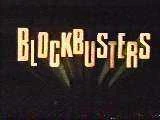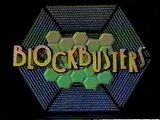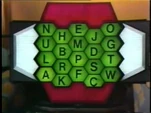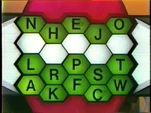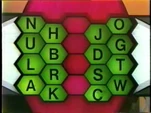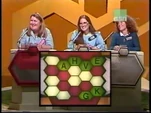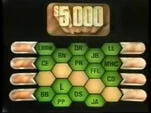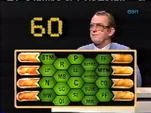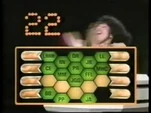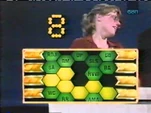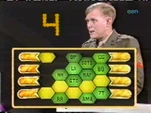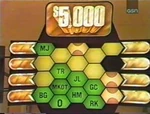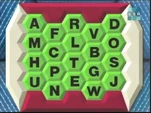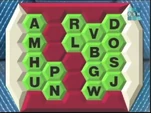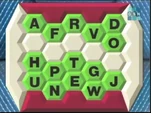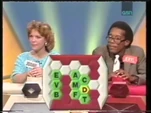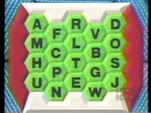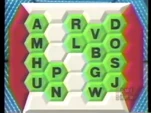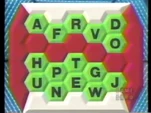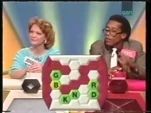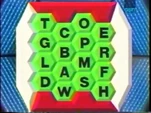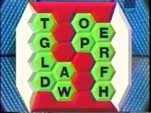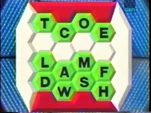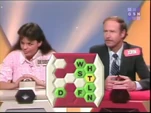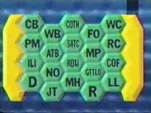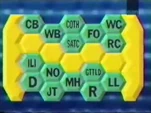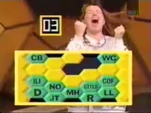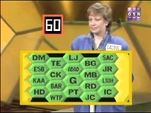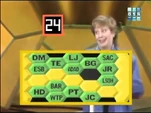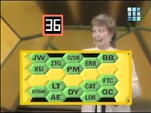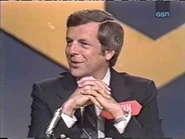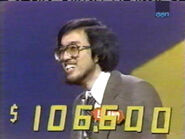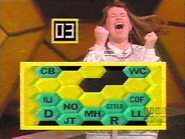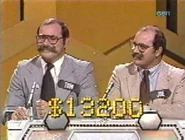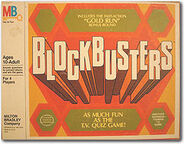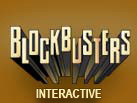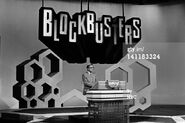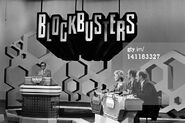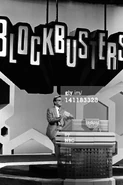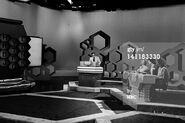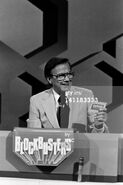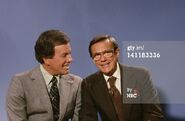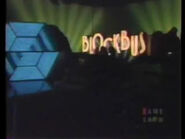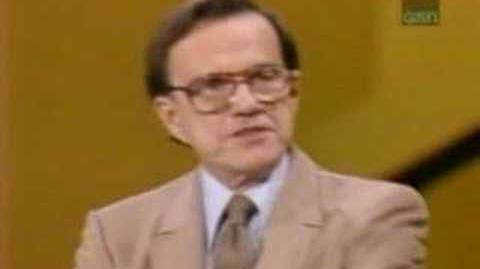| Hosts | |
| Bill Cullen 1980-1982 Bill Rafferty 1987 | |
| Announcers | |
| Bob Hilton 1980-1982 Rich Jeffries sub in 1982, 1987 | |
| Broadcast | |
| NBC: 10/27/1980 - 4/23/1982NBC: 1/5/1987 - 5/1/1987 | |
| Packagers | |
| Mark Goodson-Bill Todman Productions 1980-1982/ Mark Goodson Productions 1987 | |
1980 Opening Spiel:
"This is the battlefield for our game of speed & strategy. These are the letters that/which lead to victory on...Blockbusters! And here's the star of our show/Blockbusters, BILL CULLEN!"
1987 Opening Spiel:
"Get ready for our game of skill & strategy. Blockbusters! And here's the star of Blockbusters, BILL RAFFERTY!"
A game of skill and strategy, where the game board was a honeycomb filled with letters. This show originally pitted a solo player against a family pair to see if two heads really are better than one.
Front game
A 4x5 board of 20 hexagons is presented with a letter in each hexagon. A letter is chosen at random to start a game. The answer of the question would begin with the letter chosen. For example, if the letter B were chosen, a sample question might be: "What 'B' is a long silver rod twirled by a majorette or cheerleader?", in which case the correct answer would be "Baton". The player who buzzes in first gets a chance to answer the question. If correct, the space is marked with their color. If they are incorrect, the second player/pair gets a chance to answer (should the solo player miss, only one half of the family pair could answer, with conference). If nobody answers correctly, another question is asked whose answer began with that same letter.
The solo player would have to connect from top to bottom (red to red), which can be done in as little as 4 correct answers. The family pair would have to connect from side to side (white to white) in as little as 5 moves. Completing a path earned the player/pair $500, with two games needed to win the match, $1,000 and advance to the bonus round called "Gold Rush/Run". Originally, each win was worth a trip to the "Gold Rush/Run", with no money awarded for the front game.
Due to the interlocking patterns of the hexagons, it was impossible for a game to end in a tie.
Gold Rush/Gold Run
The player has to connect from side to side (gold to gold) in 60 seconds or less. The difference here was that many of the hexagons had multiple letters on them (1 to 5 letters), and naturally, they represented an answer of more than one word (eg: "BS", What people kiss in Ireland: Blarney Stone). Correct answers mark the chosen hexagons gold, but wrong answers or passes put up blocks and the player must work around them. If the contestant makes the connection, he/she wins $2,500 (on the first time) or $5,000 (on the second time). If time expires, the player gets $100 for every captured hexagon. If he/she gets blocked out, the contestant could still continue and try to build up the consolation prize of $100 for every correct answer until time ran out. After the show began awarding money in the match, Gold Rush was always played after each match for $5,000. Either way, win or lose, Bill would go over any missed and/or passed questions, and another match would begin. If the family pair advanced to the bonus round, only one of them could play.
1980 Pilot
In the pilot, it took $500 to win the match. A regular game of Blockbusters was played, with the first side to make the connection winning $250. That player/team then played a game called "Shortcut to Victory". Bill asked three Gold Run-style questions. If the contestant could answer all three questions correctly, it paid $250, ending the match immediately. If the contestant stumbled along the way, the opposing side received the $250, and a second game of Blockbusters was played to determine the winner of the match. For the Gold Run, the four gold bars on the right-hand side of the board concealed money amounts ($1,000/$2,000/$5,000/$10,000). If the contestant connected gold to gold, the payout was the amount hidden behind the bar adjacent to their last correct answer.
1987 revival
The show was revived in 1987 with two solo players. The champion represented white while the challenger represented red. On questions in which somebody would win the game on the hexagon that would cause either side to make the connection, Bill Rafferty referred to this situation as a "dual implication". Again, the game was best two-out-of-three, with the advantage alternating between players in the first two games. If a tie is achieved, a 4x4 tiebreaker board is used and either player could win in as few as four moves (white still went from left to right, and red still went top to bottom). Each game was worth $100 instead of $500.
The Gold Run was played exactly the same as before, with one exception that was added toward the end of the run. If the player won, he/she received an accumulating jackpot that started at $5,000 and increased by that amount for each unsuccessful attempt. The jackpot reset to $5,000 each time a new champion was crowned.
Championship Formats
From the beginning until the change in the front game format, the longest that champions could stay on the original Blockbusters was eight matches. If they won all 16 bonus rounds that they played, they would retire with $60,000.
After that, each champion was permitted to stay up to ten matches, with the top possible payout once again being $60,000.
Later in the show's run, the match limit was doubled to twenty, making the potential payout $120,000. Also, retired 10-time champions started to return to the show in an attempt to add more to their winnings.
The revival's champions could stay until they won ten matches or were defeated. Theoretically, contestants winning their last Gold Run in this version would retire with at least $52,000 (including Gold Run consolation prize winnings).
Big Champions
Solo players
John Hatton: The show’s biggest champion solo player who was a psychologist from California. His first day was on a day when the board went loopy. Other than that, he was one of several contestants who was invited back after the limit rose. His first time playing netted him the full $60,000. At one point during his first run, his house burned to the ground after a single taping; during that time, he was asked to leave the show to straighten things out and then come back on a future show, but he declined just to continue his run. During his second run, he appeared to lose his 19th Gold Run when he supposedly answered a question incorrectly; however, the answer that he gave for that question, "John Audubon", was ruled correct after the staff did their research and realized their mistake. John was awarded the $5,000 because he would have made the connection. He played his 20th and final Gold Run with no problems, retiring with the full $120,000.
LaRae Dillman: Had two separate runs as champion having won $65,000. She was the only one who retired as champion during the first format having won $47,000 at that time. She also appeared as a contestant on The New $25,000 Pyramid in 1982, Sale of the Century in 1989 and Russian Roulette in 2002.
Leland Yung: A contestant on Password Plus in 1979, winning $16,000 there, Leland came to Blockbusters, playing his first ten matches to a tee and winning $51,000. When he returned in March 1982, Leland won another $55,600 for a grand total of $106,600. He graduated from UCLA in between his runs.
Kandi Doyle: During her two separate runs as champ won $62,800 (her first run won her $50,800). She came on the show after Leland Yung had his first retirement.
Sherry Lucas: During the 10-game limit, she was tied with John Hatten as the biggest winner at that time with a perfect score of $60,000. She was later invited back with the 20-game limit, but she did not go the full 20 times. Sherry finished with $66,500.
Gene Vissich (female): She was the last solo player on the show although she was actually a returning champion having won ten matches. She didn't win many of her Gold Runs, but her final total was $51,700 ($46,700 in her ten matches). She only played one game in her return, due to the fact it was the final episode. She got $5,000 for winning it.
Jeanne Pierce: She was the only retired undefeated champion from the 1987 revival. She picked up the full $52,000, plus $1,000 in Gold Run consolation prize money, for a grand total of $53,000. Jeanne later appeared on Sale of the Century.
Family pairs
Joe & Tom Hendricks: These twins were the first championship family pair on the show, winning $26,800. Tom also appeared on Match Game & later Trivia Trap in 1984.
Alan & Jeff Dennis: These twins won five of the ten trips to the Gold Run and won $37,700. They did return with the 20-game limit, won none of the Gold Runs, and were defeated with $40,600.
Kathy Thomas & John Shannon: A brother & sister team who appeared in the final days of 1980 and early days of 1981. In their first match, an incorrect answer for John was proven correct. Like the McCarthy's, they alternated in their turns at the Gold Run board, and retired as 10-time champs with $51,200. They were invited back with the 20-game limit and left with $59,300, not going the full 20 times.
Pat & Liz McCarthy: The show's biggest family pair champions, they were the only players of either side to win 20 consecutive times, winning the full $120,000.
Finale Shows
1982 - In the 1982 series finale, the second & final match of the day (and the final match of the series) was just a single game in which the winning side receives $5,000 (no Gold Run was played afterwards); if time had run out, the side which captured more hexagons was declared the winning side; this was all so that the show can close up shop as evenly as they can. Gene Vissich (female), a returning retired champion, won that game to give her a final total of $51,700. In the final segment after showing the audience filled with future contestants who would never get a chance (including previous champion Marge Moore with a total of $1,400), Bill Cullen read statistics regarding both the solo players & family pairs, all in answer to the questions about the handicap and the design of the board (at least five correct answers for family pairs, and at least four correct answers for solo players). 37 solo players played 175 Gold Runs and won $806,000, while 45 pairs also played 175 Gold Runs but won $767,000; the family pair side won for winning the most matches by eight while the solo players won for winning the most money by $39,000, though both sides played the same number of Gold Runs; so all in all, the format worked out great. As Bill said, "If everything else worked as well as the handicap, I would've said at a time like this, 'Goodbye, we'll see you tomorrow.'"[1]
1987 - In the 1987 series finale, one full match was played in which returning champion Patti Perrin (who wore a nice black dress) won with two straight (with & without the advantage), but she got blocked in playing the Gold Run and only picked up $400 since she put up four gold hexagons. Patti supposedly would've been playing for $10,000 but instead was playing for $15,000 since this was the show's finale (by that time, the show started adding $5,000 additional for each failure of winning the Gold Run but by that contestant only; new champions always started at $5,000). Prior to the Gold Run and as the show had been doing over the final weeks, Bill Rafferty & Rich Jeffries promoted Classic Concentration by doing a contestant plug for that show; Classic Concentration would be the show that replaced Blockbusters the following Monday. In the final segment in his goodbye speech and since Patti wasn't able to win the final Gold Run, Bill Rafferty gave Patti an additional $1,000 for a final total of $2,200, and the rest is history.[2]
The Board
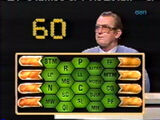
As you see, the board is completely powered by slide projectors.
In the 1980-1982 run, the game board was run by slide projectors (ala shows like Press Your Luck, The Joker's Wild and Bullseye). Each one's responsible for each of the 20 hexagons. It had lighted trapezoids on the sides which flashed with the appropriate colored hexagons (white for white & red for red). The white trapezoids double as secret doors which open up to reveal eight golden capsules for the Gold Rush/Run; as shown in one episode, the white hexagons turned gold when the transition occurs. Absent from earlier weeks, at the top of the board was a flip sign reading "$5,000" which was obviously used for the Gold Rush/Run only. At one time at the start of a show before a playing of the Gold Rush/Run, Tom Kennedy (who hosted Password Plus at the time) was inside the board and stuck his head out a top hexagon to promote the time change for Password Plus.[3] Also, late in the run, the background of the set changed from gold to blue. On two shows during Christmas time, several of the hexagons make up a Christmas tree with red & white hexagons flashing back & forth.[4]
In the short-lived four-month 1987 run, the board was completely computer-generated. The green hexagons which house the letters were bevel-typed, and in the back, the hexagons were blue with diamonds inside, similar to the ones on the set. The advantage of having a computer-generated board was that it is now animated; in the opening of the show, the hexagons fly from all directions to form the gameboard, flips over & back (at the time of the show's logo showing), then comes apart prior to host Bill Rafferty's introduction (a shot of the animation was used in the ticket & contestant plugs); at the start of a game, after the sides come in, the hexagons fly in from the sides to form the board after which the letters pop in one by one; later shows starting in March (excluding the Gold Run) had them flip zoom in; starting in February, they flip zoom out (minus the captured hexagons) when the game was over. While the home viewers saw the board on their TV sets, the contestants saw the board on a small TV monitor housed inside a giant neon blue hexagon which during the closing credits did a light show; it spun around and later wiped in (both two triangles at a time). On certain shows after the credits, while it is still wiping in light-wise, the neon hexagon zoomed out to re-reveal the set which by that point went dark save for a few spotlights and the set logo which continuously lights up a letter at a time just like the 1980 series logo during the closing. On one episode, when the game quickly went from a Gold Run to a new match with no commercial interruption, viewers could see the small TV monitor reveal itself as the Game 1 board flew in.
Merchandise
A home game by Milton Bradley was made during the later years of the 1980-82 version. It was commonly given out as a parting gift for defeated contestants.
GSN had their very own interactive version where you were allowed to play along with the show on their website.
Other Pictures
Trivia
The 1987 version of this show was the only series Bill Rafferty ever hosted on network television as all his others aired in syndication.
Rating
Music
1980 - by Bob Cobert
1987 (Original) - Music Design Group
1987 (Vamps) - KPM Music
"Run Don't Walk (a)" by Richard Myhill
"Run Don't Walk (b)" by Richard Myhill
Inventors
Additional Pages
Blockbusters/Gallery
Blockbusters/Quotes & Catcphrases
References
Links
Blockbusters at Classic Game Shows
Blockbusters at Game Show Galaxy (archived)
Blockbusters with Bill Cullen at tv-gameshows.com (archived)
Blockbusters with Bill Rafferty
Josh Rebich's Blockbusters Rule Sheets
A Blog about the Blockbusters board game from 1982
Official Pearson website for Blockbusters (via Internet Archive)
Videos
A Gold Run with a few technical difficulties
The final Gold Run from the 1982 finale
YouTube Videos
Bill Cullen's worst pun ever
The biggest Dual Implication of 1981
Tom Kennedy visits Blockbusters plus Gold Run
John Hatten's First Last Gold Run
John Hatten's Very Last Gold Run
Second Blockbusters Christmas Tree
Two Game Show Questions
Jeanne's Last Gold Run
